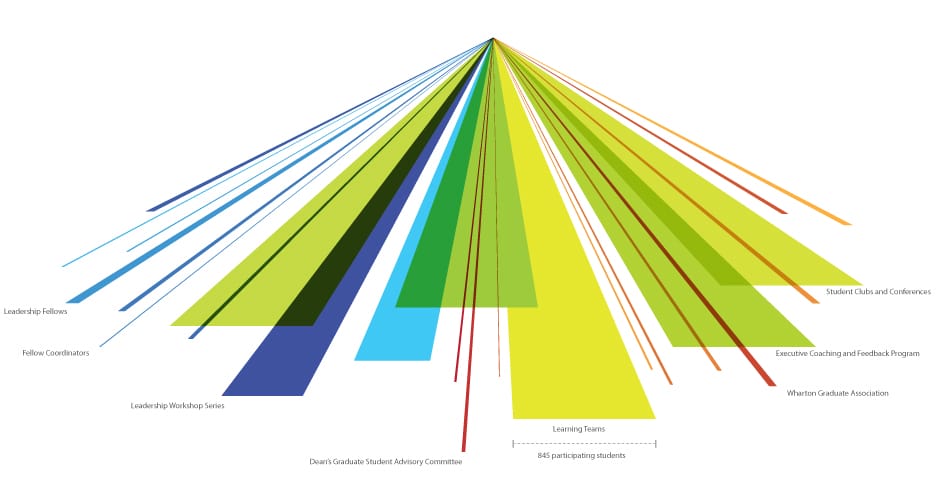A flagship leadership learning framework among higher education, Wharton’s program has widespread consequence. Yet in its success, it bumps into an age-old query.
“One of the most popular questions when you’re in leadership education is ‘Are leaders born or made?’” says Jeff Klein, WG’05, executive director of the Wharton Leadership Program. “And [Wharton] answers yes to that—it’s both.”
The Wharton Leadership Program encourages students to learn leadership in three ways: by being a student of leadership (completing courses, attending lectures and conferences, and reading books); initiating important coaching and mentoring relationships; and seeking and accepting stretch experiences. According to Michael Useem, the William and Jacalyn Egan Professor of Management, editor of the Wharton Leadership Digest, and director of the Center for Leadership and Change Management, Wharton has recognized and supported these three avenues to leadership learning over the last 15 years.
MBA, Executive MBA and undergraduate students, along with executive education participants, benefit from the Wharton Leadership Program, whether they are naturally gifted or seeking to learn new skills.
“[Our students’] futures are very bright, and they will be in positions of power and influence,” says Anne Greenhalgh, Gr’82, deputy director of the Wharton Leadership Program, “so cultivating their leadership … is really important.”
When the Wharton School recently revised its MBA curriculum, it again recognized this responsibility. Though the leadership curriculum has not changed since 2008, the School has strengthened the three components of learning leadership.
Coaching Success
The new Wharton Executive Coaching and Feedback Program (WECFP) affords all first-year, full-time MBA students access to a personal executive coach to help guide and support their leadership development. These coaches are accomplished professionals who provide feedback during four coaching sessions, helping to identify the students’ strengths, challenges and opportunities for growth.
“What an executive coach is doing for a student at Wharton is pretty much what a coach would do for an executive at Morgan Stanley or McKinsey,” explains Lynn Krage, WEV’05, the director of the Wharton Leadership Program’s WECFP. “We have the best coaches in the area working with us as part of this operation.”
But even the best coaches in the world can’t provide guidance without data points. For this reason, coaches have access to Wharton’s new online platform, developed in partnership with Qualtrics, that collects feedback on each student. Wharton students participate on approximately 15 to 20 teams during their MBA experience, and the platform allows them to collect feedback from these teams. This new tool is designed to help increase a student’s self-awareness and provide the appropriate executive coach with data.
“It’s a giant investment the School is making,” says Klein.
But this investment wasn’t made without extensive due diligence. In 2009, Dean Thomas S. Robertson asked eight faculty members to evaluate and suggest changes to the MBA curriculum. The committee—known as the MBA Review Committee or MBARC—gathered information from 4,000 stakeholders, including students, faculty, alumni, recruiters and employers. MBARC uncovered opportunities to increase individual-level leadership learning and self-awareness among students. Armed with this insight, the Wharton Leadership Program began to explore executive coaching.
Krage and her colleagues examined coaching at organizations like Deloitte, Estee Lauder and Citi and studied coaching scholarship and best practices. An advisory board of faculty, alumni, students and staff provided additional thoughts and guidance on coaching. The Wharton Leadership Program next implemented a pilot executive coaching program with 50 students. The idea was extremely popular with students; 243 responded to an email request for participation, and the final group was then selected randomly.
“We collected data on the student experience, on the coach experience. We collected data on the students’ development and their own changes. We collected information about what they were working on when it came to their development,” explains Krage.

This analysis indicated that the structure of the pilot program was “overwhelming successful.”
“There’s little that’s more powerful than sitting down one-on-one with someone,” Krage adds.
The Wharton Leadership Program has scaled this program, making it available for any first-year MBA student who chooses to opt-in, beginning with the Class of 2014.
Students of Leadership
Both undergraduate and MBA students at Wharton are introduced to leadership scholarship in their first semester, through Management 100 and Management 610, respectively.
These aren’t your typical classes. Management 100—the key undergraduate leadership course—is “upside-down, backwards and high-touch,” according to Greenhalgh, who is course head. Each student is a member of a team of 10, working with a nonprofit organization on a specific project or performing an external communications audit for a local entrepreneur. Course readings are chosen to support the students in their team projects, and students are required to learn about leadership, communication and teamwork by doing.

“It’s the on-the-ground project experience that really is the text of the class,” Greenhalgh says.
She adds: “Much of the Wharton undergraduate experience is about wedding theory and practice. It’s just that in Management 100, we do it with gusto.”
And, according to undergraduate alumni, this gusto helps the course to stand out.
“It’s a great class for freshmen to have,” says Xenia Kolesnikov, W’10. “It definitely builds your framework on how you should approach [problems], and it gives you an understanding of what leadership skills are and what teamwork skills are.”
For MBA students, Management 610 serves as the introductory leadership course. Redesigned four years ago, the course simulates the management of an electric car company.
As students work in teams to run their “company,” they learn about leadership behaviors, team dynamics and organizational awareness. Also including lectures, readings and class discussion, the course places special emphasis on performance analysis, and requires online self and peer evaluations. This course is the foundation for all leadership learning for MBA students.
Putting it to the Test
Wharton students test and build on this academic foundation in a variety of environments—from nonprofit boardrooms to Red Rocks Desert and Mt. Kilimanjaro—through the Wharton Leadership Program’s experiential learning and co-curricular offerings.
More than 600 graduate students and nearly 900 undergraduate students participate in the Wharton Leadership Ventures annually. These programs require students to work as a team as they summit peaks, cross oceans or hike the Appalachian Trail. From the U.S. Marine Corps Officer Candidate School at Quantico to the Atacama Desert to the wilderness of Quebec, undergraduate and graduate students alike participate in “stretch experiences” in order to enhance their leadership skills.
“They may never be at 17,000 feet moving up … a mountain in Ecuador again, but they will be on a new team again.
They will have to learn new skills, and they will be in new environments,” says Klein. “They can learn a lot about what they need to be successful, how they can contribute and what a team needs to be successful.”

Ashini Desai, WG’09, a leadership fellow who went on a trek to Antarctica, agrees: “Going into it, I didn’t fully appreciate
the situation that they were putting us in, and how that was going to relate to leadership.”
“In eight days, we learned some really valuable lessons, [including] making sure everyone buys into the agenda and recognizing that one person driving his or her own agenda makes the whole team suffer. It was incredibly eye-opening,” Desai explains.
The Wharton Leadership Program offers more than outdoor adventures. Students can take advantage of numerous workshops with unique twists, from group creativity with the Pig Iron Theatre Company to meditation to Aikido. These unusual workshops put students in new environments and test their leadership.
And the variety of workshops is only enhanced by Penn’s vast network. Seychelle Hicks, W’08, participated in a workshop at Penn’s trauma center and watched how doctors and nurses respond to critical patients.
“To see leadership in a whole different … way, and to see that what we learn every day at Wharton is applicable in almost any and every industry, was really amazing,” Hicks says.
As its students learn to lead through these three different and complementary methods, the School has taken a prominent role among institutions with leadership programs.
According to Useem, who has fielded requests by multiple corporations and nonprofits about creating leadership programs at their organizations, Wharton is on the cutting edge of leadership learning.
“We’ve distinctly provided [leadership opportunities] in a way that most other business schools have not,” he says. “I think that most of them will in the decade ahead, so the School has been a bit ahead of the curve.”

Performance Peak: Developing leaders is at the heart of Wharton’s mission and our contribution to the greater social and economic good. Wharton has a breadth of leadership development opportunities including intense classroom learning, co-curriculars and interest-driven extra-curriculars that enable you to cultivate your leadership style and assume the lead position in whatever comes next.

























